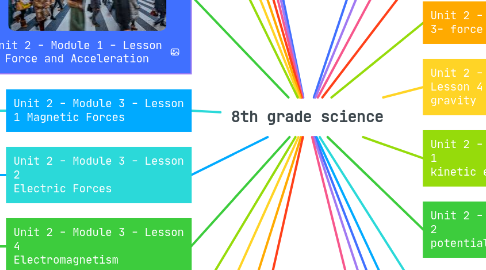
1. Unit 2- Module 2 - Lesson 3 Conservation of Energy
1.1. Mechanical Energy
1.1.1. Changes between kinetic and potential energy
1.1.1.1. Conservation of Energy
1.1.1.1.1. Work
2. Unit ! moudle 2 lesson 1
2.1. James waston
2.1.1. Francis Crick
2.1.1.1. Rosalind Franklin
2.1.1.1.1. Double Helix
3. Unit 1 - Module 2 -Natural section and adpatiations
3.1. charles darwin
3.1.1. Galapagos Islands
3.1.1.1. HMS Beagle
3.1.1.1.1. Darwins Finches
4. Unit 1- module 2 - lesson 3
4.1. selective breeding
4.1.1. Genetic Engineering
4.1.1.1. Genetically Modified organism
5. Unit 1 - Module 3 - Lesson 1 and 2
5.1. Fossil Formation
5.1.1. Mineralization
5.1.1.1. Carbonization
5.1.1.1.1. Molds and Casts
6. unit 1- module 3- lesson 2
6.1. Homologous Structures
6.1.1. Analagous Structures
6.1.1.1. Vestigial Structures
6.1.1.1.1. Embryology
7. Unit 2 - Module 1 - Lesson 1 postion and mostion
7.1. Reference Point
7.1.1. Position
7.1.1.1. Displacement
7.1.1.1.1. Average Speed
8. Unit 2 - Module 1 - Lesson 2 Force and Acceleration
8.1. Acceleration
8.1.1. Forces
8.1.1.1. Contact Force
8.1.1.1.1. Newton's 2nd law of motion
9. Unit 2 - Module 3 - Lesson 1 Magnetic Forces
9.1. Magnet
9.1.1. Ferromagnetic elements
9.1.1.1. Magnetic Force
9.1.1.1.1. Magnetic Poles
10. Unit 2 - Module 3 - Lesson 2 Electric Forces
10.1. Charges
10.1.1. Electric Field
10.1.1.1. Electric Field Strength
10.1.1.1.1. Electric Potential Energy
11. Unit 2 - Module 3 - Lesson 4 Electromagnetism
11.1. Electromagnetism
11.1.1. Electric current magnetic fields
11.1.1.1. Increasing magnetic field strength
11.1.1.1.1. Controlling electromagnets
12. Unit 3 - Module 2 - lesson 1-Light
12.1. light
12.1.1. Radiant Energy
12.1.1.1. Light energy
12.1.1.1.1. Light Brightness
13. Unit 3 - Module 2 - Lesson 2 Reflection and Mirrors
13.1. Law of reflection
13.1.1. Virtual image
13.1.1.1. Concave Mirrors
13.1.1.1.1. Focal Point
14. Unit 4 - Module 2 - Lesson 2 Lunar Phases
14.1. The moon
14.1.1. Lunar Phase
14.1.1.1. Waxing Phases
14.1.1.1.1. Waning phases
15. Unit 4 - Module 1 - Lesson 1 Earth and Human Activity
15.1. Population
15.1.1. Natural Resource
15.1.1.1. Carrying Capacity
16. unit 1 module 0 section 2 gathering and analyzing data
16.1. Claim
16.1.1. Evidence
16.1.1.1. Reasoning
17. unit 1 module 0 section 5 lab safety standard
17.1. hair in the lab
17.1.1. clothing in the lab
17.1.1.1. foot wear in the lab
17.1.1.1.1. protective glasses
18. Uniit 1 moudule 1 Lesson 1 Analyzing the Rock and Fossil Records
18.1. Uniformitarianism
18.1.1. Absolute Age
18.1.1.1. Relative-age dating
18.1.1.1.1. Sediment
19. Unit 1 module 1 lesson 2 geoglogic timeline
19.1. Unconformities
19.1.1. Angular Unconformity
19.1.1.1. Disconformity
19.1.1.1.1. Nonconformity
20. Unit 2 - Module 1 - Lesson 3- force pairs
20.1. Newtons 3rd law of motion
20.1.1. Force Pairs
20.1.1.1. Normal Force
20.1.1.1.1. Collision Forces
21. Unit 2 - Module 1 - Lesson 4 gravity
21.1. Noncontact Force
21.1.1. Gravitational Force
21.1.1.1. Gravitational Force and Mass
21.1.1.1.1. Gravitational Field
22. Unit 2 - Module 2 - Lesson 1 kinetic energy
22.1. Kinetic Energy
22.1.1. Kinetic energy and mass
22.1.1.1. Kinetic Energy and Speed
23. Unit 2 - Module 2 - Lesson 2 potential energy
23.1. Potential Energy
23.1.1. Elastic Potential Energy
23.1.1.1. Gravitational Potential Energy
24. Unit 2 - Module 3 - Lesson 3 Simple Circuits
24.1. Simple Circuit
24.1.1. Closed Circuit
24.1.1.1. Open Circuit
24.1.1.1.1. Charged Particles
25. Unit 3 - Module 1 - Lesson 1 Introduction to waves
25.1. Wave
25.1.1. Vibration
25.1.1.1. Transverse Wave
25.1.1.1.1. Mechanical Wave
26. DRY
26.1. LENSES
26.1.1. L-Lable and List
26.1.1.1. E- Equation
26.1.1.1.1. N- Notice
27. unit 1 module 0 section 1 scientific method
27.1. observation
27.1.1. quantitative observation
27.1.2. qualitative observation
27.1.2.1. questions
27.1.2.1.1. hynpothesis
28. Unit 3 - Module 1 - Lesson 2 Mechanical Wave Interactions
28.1. Reflection
28.1.1. Absorption
28.1.1.1. Transmission
28.1.1.1.1. Diffraction
